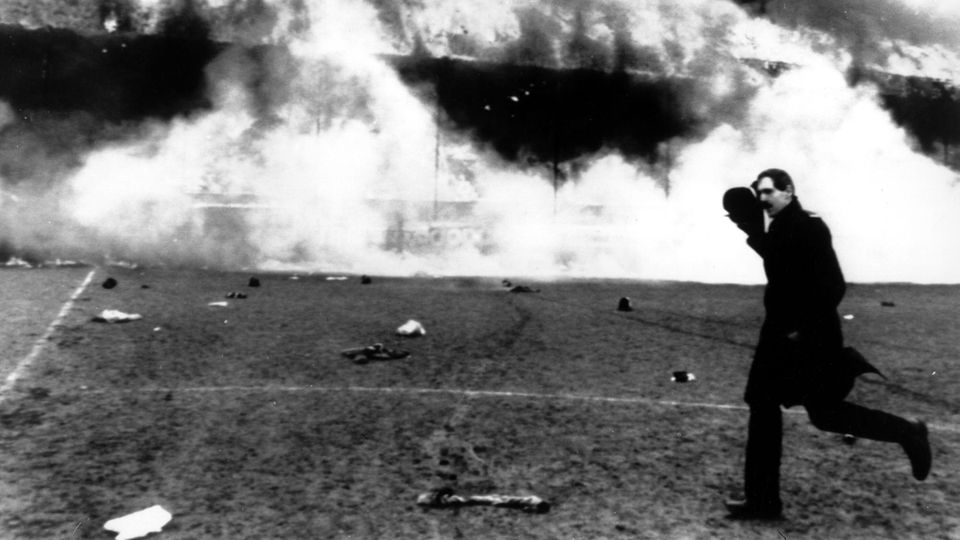In May 1985 there was a serious accident in Bradford, England. During the third division team Bradford City’s game against Lincoln City at the Valley Parade Stadium, the wooden stadium stand catches fire. It rages so quickly that the spectators barely have time to escape the flames.
When the Bradford City players stepped onto the pitch on May 11, 1985, the mood couldn’t have been more exuberant. With a 2-0 win against Bolton Wanderers in the penultimate game of the season, they had already won the Third Division championship title and were promoted to the Second Division. That hasn’t happened for 48 years. So today they can play against the guests from Lincoln City without any pressure. This is one of the reasons why the Valley Parade Stadium in the English county of West Yorkshire was almost sold out with 11,076 spectators on that Saturday afternoon. Around 3,000 spectators made themselves comfortable in the 80-year-old wooden grandstand. The approximately 90 meter long structure is located on the slope of a hill. Access is via a long corridor that extends almost the entire length of the back of the stands. The plans for the new season include demolishing the old wooden structure and replacing it with a steel structure. The wooden terraces are to be replaced with concrete. The supports for the main stand are already ready, right next to the parking lot. Demolition work is due to begin two days after the game at a cost of around £400,000
As early as July 1984, the club received a warning – from an engineer from the district council. He complained about the accumulation of rubbish under the stands due to a gap between the seats. There’s all sorts of stuff there – cigarette and matchboxes, plastic cups and bottles, newspapers and bags of chips. It is said that even a carelessly thrown away cigarette could cause a fire catastrophe. Nobody expects that something like this would happen today of all days.
At first, no one took the Bradford City fire seriously
Before kick-off, the players were overjoyed to receive the trophy. What follows could be described as a “tired kick”. Shortly before half-time it is still 0-0 in the Valley Parade Stadium. The game will be broadcast live on TV. It was 3:41 p.m. when commentator John Helm noticed the fire in the stands three rows behind the G block. “We actually have a fire in the stands on the other side of the pitch. And that looks very nasty indeed.” But none of the spectators notice the tragedy unfolding before their eyes. Dave Evans, a Bradford City player, remembers how the fans in the stands suddenly became restless. “We didn’t understand what was going on.”
Karl Hepton is one of the survivors who remembers the day in a TV documentary. The then 9-year-old was at the stadium with his 64-year-old grandmother. “At first people laughed and sang that they should pee out the fire. Then they started moving away from the smoke.” The game is interrupted and the fire spreads rapidly. Fanned by gusts of wind, the smoke and flames shoot across the rows of seats. Because the heat builds up under the wooden roof covered with asphalt panels, a so-called fire jump occurs after just around two minutes and the highly flammable wooden roof covered with tar paper and sealed with asphalt suddenly explodes into flames. The heat is so intense that it can be felt throughout the stadium. Burning wood and melted materials fall from the roof onto spectators, who barely have time to get to safety.
“Suddenly the smoke washed over the back of the stands like a wave,” remembers the then 26-year-old police officer Glynn Leesing. “The smoke was acrid and like tar. Really thick, black and caustic – just horrible. We tried to direct people onto the pitch, but they didn’t listen to us and ran in panic to the back of the stands. The corridors are there too shrouded in black smoke, people are now crowded together in the aisles, pushing and shoving, stumbling over each other. “I heard them screaming and moaning on the ground,” said Karl Hepton, whose grandmother is also desperately trying to get over the back of the fire hell stand to escape. The only fire extinguishers on site are not within easy reach.
Exits and turnstiles in the stadium are locked with locks
David Hall is at the stadium with his father on that fateful day. The old man can no longer walk well. Now his son is urging him to climb over the rows of seats with him. “He was big and heavy and could hardly breathe. We got down to the standing section very slowly and sluggishly. It took forever.” Although there is no fence between the stands and the field, there is a wall that is higher on the inside than on the side facing the field. There are no steps to climb on or poles to climb up. “Anyone who wasn’t physically able to lift themselves over it or wasn’t pushed over had no chance,” said Leesing, who, together with his colleagues and stadium visitors, helped as many people as possible over the wall.
At the back of the stands, people are frantically trying to escape via the turnstiles and the exits. But these are locked with padlocks and there are no folders to open them. Many are crushed trying to crawl under the turnstiles. In a panic, a few strong men throw themselves against the exits and manage to open some of the doors.
Up in the back of the stands, Hepton’s grandma continues to fight her way through the thick, toxic smoke, past a stadium kiosk. “At some point a hand pulled me and my grandmother in,” says Karl Hepton. “It was gray and I could see the pitch for the first time in what felt like forever.” The man breaks a window at the front of the kiosk. “My grandma picked me up, dangled me over the window ledge and lowered me down to the seats. She told me, ‘Run! Run!’ And that’s what I did.” He pulls his scarf over his face, slides his hands under the sleeves of his jacket and jumps over the folding seats. “My scalp hurt from the drops of melted tarpaulin.” He managed to climb onto the pitch.
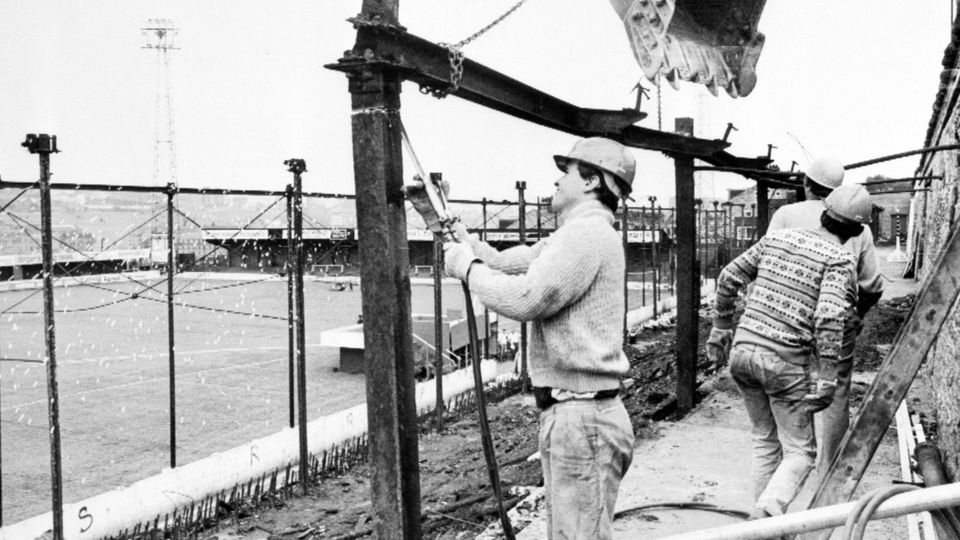
From there, police and civilians tirelessly come running to help people over the wall. “We were always running back and forth. But to get oxygen and breathe fresh air, you had to cross half the field,” remembers then police chief Terry Slocombe. “At some point you knew you couldn’t run back to save more people. That was a very painful moment.” This is also the experience of David Hall, who makes it to the wall with his father. “I climbed over and ran into the field to a police officer and asked him to help me save my father. But he told me it was too late.” He watches helplessly as his father is swallowed by the thick smoke and blazing flames.
56 people die and at least 265 are injured
People stagger around on the field like zombies. Some have their hair and parts of their clothing burning, while others have their skin hanging in shreds. A man is completely engulfed in flames as he walks across the lawn. Almost like he was taking a walk. A few men immediately pounce on him and smother the flames. He made it to the hospital, but later – like so many others – succumbed to his serious injuries. At 3:48 p.m. – just four minutes after the fire broke out – the stands were ablaze. Although the fire department arrived immediately, they arrived too late.
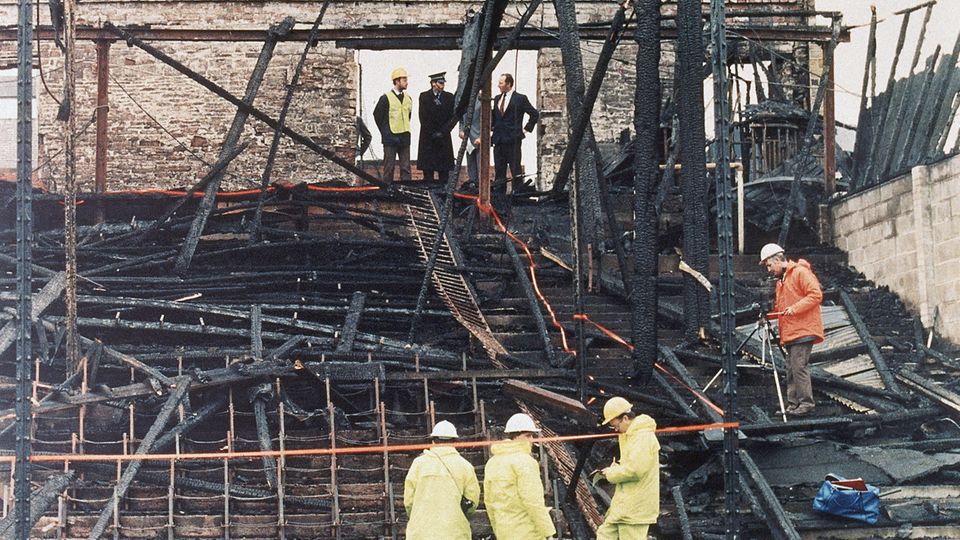
56 people lost their lives that day, including eleven children. The youngest victims, three boys, are eleven years old. The oldest victim is an 86-year-old former chairman of the football club. A majority of the dead are found near the rear exits and the turnstiles in the center back of the stand. Most died of smoke inhalation. Some are still sitting in their seats, burnt beyond recognition. Others succumb to their serious injuries in hospital weeks later.
Police worked under lights until 4 a.m. the next morning to recover all the bodies. They try to determine the identity of the victims with the help of jewelry, clothing and tooth remains. At least 265 people are injured. Most suffer severe burns, sometimes have to undergo multiple operations and are in hospital for months. The public’s sympathy for their fate is huge. The club’s players, coaches and officials regularly visit the survivors in the hospital. The heir to the British throne, Prince Charles and Princess Diana, also encourages the patients on site.
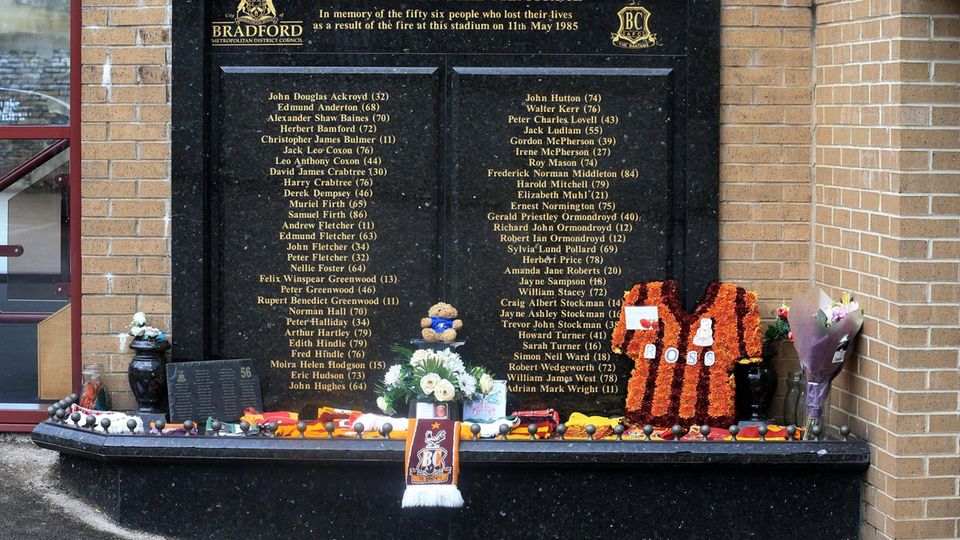
Meanwhile, an investigative commission is busy finding the cause of the devastating fire. She later concludes that a discarded cigarette was responsible. This ignited the mountains of rubbish that were stored under the stands. During the clean-up work, the police found remnants of newspapers from 1968 as well as old coins and cigarette packs. On February 23, 1987, the FC Bradford City club was found guilty in a test case and ordered to pay millions in damages. A third of the legal responsibility falls on the relevant West Yorkshire regional authority. As a result of the investigation, new wooden stands will be banned from all UK sports grounds and other wooden stands deemed unsafe will be closed immediately. A smoking ban in such stands will also be introduced.
Martin Fletcher, a survivor who lost his father, grandfather, younger brother and uncle that day, has a different theory. Research into his book “Fifty-Six: The Story of the Bradford Fire”, published in 2015, reveals that it was not the only fire linked to then club boss Stafford Heginbotham. At least eight further fires between 1967 and 1981 are said to have brought him around £2.74 million in insurance money from various compensation payments. According to Fletcher, he was facing financial ruin at the time and was unable to pay for the renovation work that had become necessary as a result of his promotion. He doesn’t directly accuse Heginbotham of arson, but asks the question: “How can one man alone be so unlucky?”
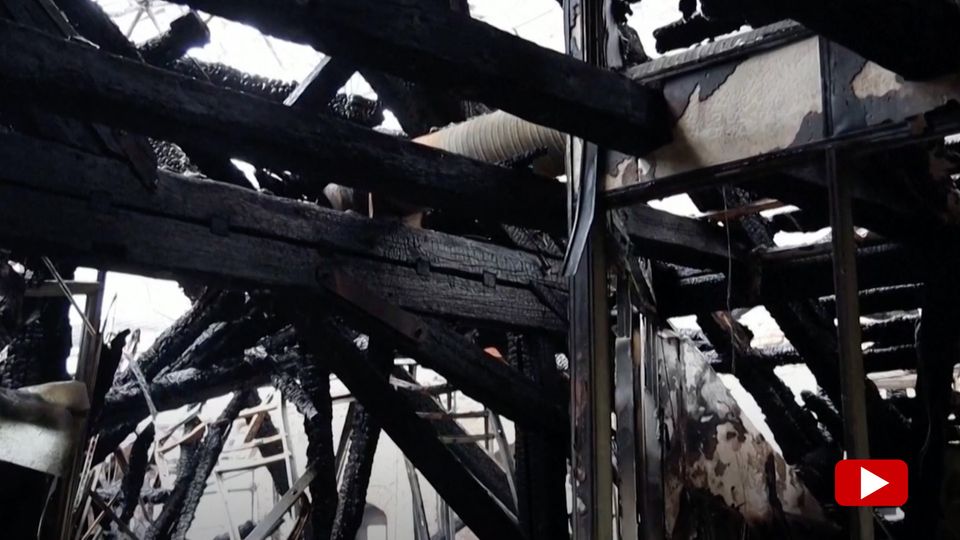
Major fire at the historic stock exchange: photos from the interior show the destruction
01:38 min
Watch the video above: Half of the historic stock exchange in Copenhagen was destroyed in a major fire. It is still unclear what exactly caused the fire. Now photos from inside the building have been released.
Sources: , , , ,
Source: Stern
I am Pierce Boyd, a driven and ambitious professional working in the news industry. I have been writing for 24 Hours Worlds for over five years, specializing in sports section coverage. During my tenure at the publication, I have built an impressive portfolio of articles that has earned me a reputation as an experienced journalist and content creator.

